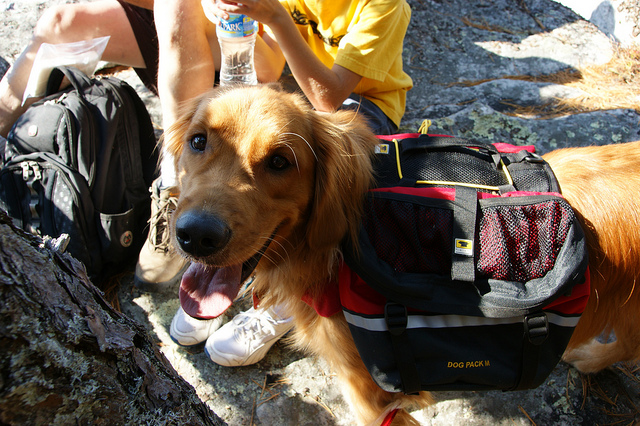
BY KELLY DUNNING
For me, backpacking and dogs go together like wool socks and hiking boots: It just makes sense to put ‘em together.
A dog makes an ideal hiking partner because they’re curious, full of energy and happy to follow you anywhere you want to go. And they love all the extra exercise they’re getting.
However, if you and Fido have never been on a backpacking trip together before, there are a lot of things you should know before you set off. So to learn more about the fine art of backpacking with a furry companion, I consulted Chris Puls and Lonnie Olson of Dog Scouts of America, the scouting organization for dog owners and their dogs.
Here are a few tips that these outdoor canine experts had to share with me:
Which Dogs Are Best for Backpacking?
“We believe that all dogs can and should be able to enjoy backpacking with their pet parents,” says Lonnie Olson, founder of Dog Scouts of America.
“If you’re a die-hard backpacker and want to use your dog as a pack-mule, then obviously you’re going to need one of the larger, hardier breeds. But if that’s the only reason you’re taking your dog along, I suggest using a donkey. Most of us, though, hike with our dogs because we enjoy our canine companions and it is a bonding experience for us.”
Although all dogs are capable of hiking, it is important to adjust your expectations of your trip according to what your dog can handle based on their fitness level, conditioning and the weather.
Dog Scouts president Chris Puls says, “If the dog is used to laying around all week when the owner is at work, it wouldn’t be wise to expect them to do a long, strenuous hike on the weekend.”
If your dog is a little out of shape, consider taking them on a few shorter walks beforehand to build up their fitness before you go on a long hike. Also, Puls notes that dog breeds with short snouts will naturally struggle to breathe during long hikes, especially in warm weather or at high altitude – so be sure to keep this in mind.
What Gear Should You Bring With You?
Before your trip, it is important to prepare with the right gear for the trail. Puls advises against letting your dog drink from a lake or a stream. “It’s not wise to trust wild water sources because they can contain harmful bacteria, like giardia, that can make the dog sick and require vet care,” explains Puls. “Blue-green algae can cause rapid death if ingested.”
Instead, bring plenty of water for your dog – a collapsible water bottle will make it easier to carry and will avoid the water sloshing against your spine.
When choosing a backpack for your dog, make sure that it sits on their shoulders rather than on their spine, as it will cause discomfort during a long hike. You find a variety of different dog packs, including hydration packs, at several outdoor retails stores such as REI.
Puls also recommends that you bring a first aid kit in case you or your canine companion gets injured and also make sure that your dog has microchips, tattoos and collar tags so that they can be identified if you get separated. Your dog’s ID tags should have the number of a cell phone you have with you, so you can be reached immediately.
Bring treats along for both you and your dog such as energy bars and dog snacks. They will keep you going and can be used to reward good behaviour.
Here’s a quick list of other dog-focused supplies that Olson recommends:
- Signalling device
- Spare collar
- Leash
- Poop bags to clean up after them
- Dog booties
- Rain jacket for your pet
What Are The Top Tips For On the Trail?
“It’s not safe for a dog to be out of your sight in the woods because of traps set for wildlife, dangerous animals (snakes, porcupines, bears, coyotes, etc.) and hidden dangers like holes, cliffs and deadfalls,” warns Puls.
Also, other trail users might not feel comfortable around dogs and will not appreciate your happy slobbering pooch running up to them. Puls recommends keeping your dog on a leash at all times when hiking.
“A waist leash is a handy tool, as it frees up your hands for using hiking poles,” Olson recommends, “I use one that has a built in shock bungee, so that the dog isn’t jolting your spine each time the leash goes tight.”
Don’t forget to also clean up after your pet – no one wants to soil their hiking boots with the mess your friend has left behind!
With these tips in mind, you will be ready to start planning your wilderness trek with your furry best friend at your side. Hopefully it will be the first of many great adventures that you take together.
Kelly Dunning is a Canadian freelance writer and digital nomad with a love of hiking, nature, art, culture, literature and adventure. She and her English boyfriend Lee run Global-Goose.com, a site packed full with travel guides, stories and inspiration for those who dream of travel.


